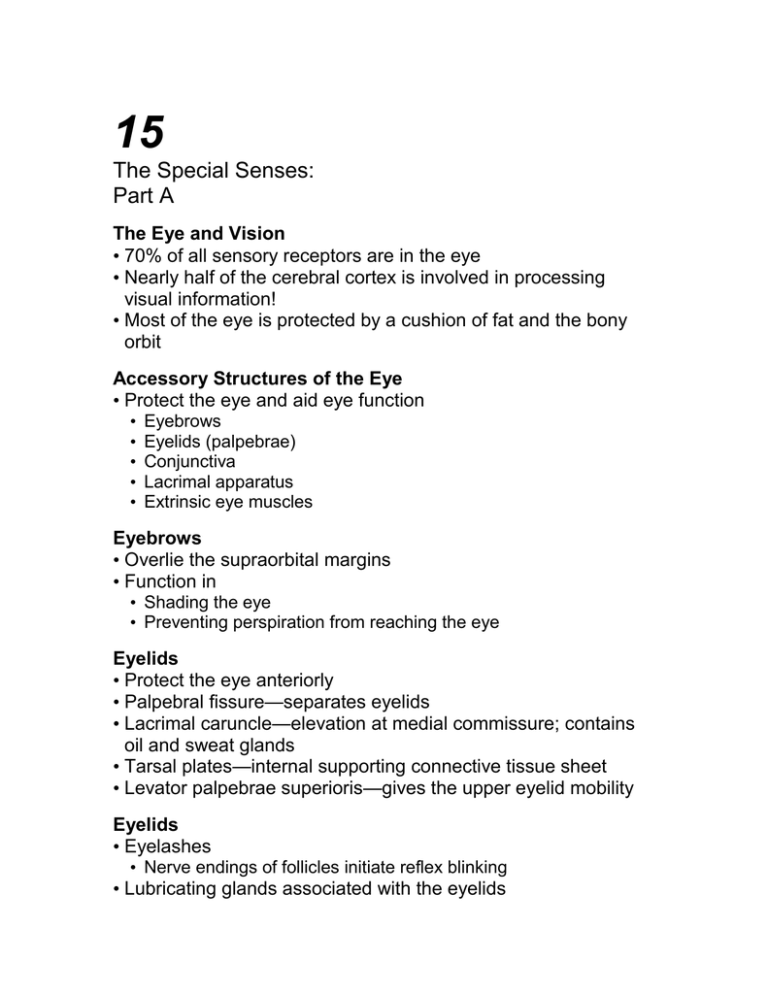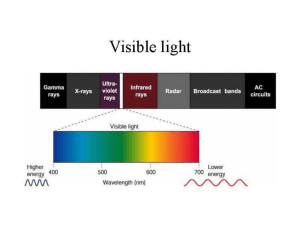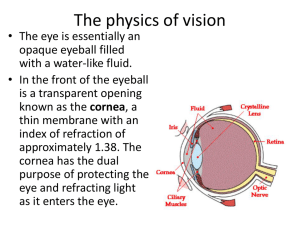Chap 15A
advertisement

15 The Special Senses: Part A The Eye and Vision • 70% of all sensory receptors are in the eye • Nearly half of the cerebral cortex is involved in processing visual information! • Most of the eye is protected by a cushion of fat and the bony orbit Accessory Structures of the Eye • Protect the eye and aid eye function • • • • • Eyebrows Eyelids (palpebrae) Conjunctiva Lacrimal apparatus Extrinsic eye muscles Eyebrows • Overlie the supraorbital margins • Function in • Shading the eye • Preventing perspiration from reaching the eye Eyelids • Protect the eye anteriorly • Palpebral fissure—separates eyelids • Lacrimal caruncle—elevation at medial commissure; contains oil and sweat glands • Tarsal plates—internal supporting connective tissue sheet • Levator palpebrae superioris—gives the upper eyelid mobility Eyelids • Eyelashes • Nerve endings of follicles initiate reflex blinking • Lubricating glands associated with the eyelids • Tarsal (Meibomian) glands • Sebaceous glands associated with follicles • Ciliary glands between the hair follicles Conjunctiva • Transparent membrane • Palpebral conjunctiva lines the eyelids • Bulbar conjunctiva covers the white of the eyes • Produces a lubricating mucous secretion Lacrimal Apparatus • Lacrimal gland and ducts that connect to nasal cavity • Lacrimal secretion (tears) • • • • Dilute saline solution containing mucus, antibodies, and lysozyme Blinking spreads the tears toward the medial commissure Tears enter paired lacrimal canaliculi via the lacrimal puncta Drain into the nasolacrimal duct Extrinsic Eye Muscles • Six straplike extrinsic eye muscles • Originate from the bony orbit • Enable the eye to follow moving objects • Maintain the shape of the eyeball • Four rectus muscles originate from the common tendinous ring; names indicate the movements they promote • Two oblique muscles move the eye in the vertical plane and rotate the eyeball Structure of the Eyeball • Wall of eyeball contains three layers • Fibrous • Vascular • Sensory • Internal cavity is filled with fluids called humors • The lens separates the internal cavity into anterior and posterior segments (cavities) Fibrous Layer • Outermost layer; dense avascular connective tissue • Two regions: sclera and cornea 1.Sclera • Opaque posterior region • Protects and shapes eyeball • Anchors extrinsic eye muscles Fibrous Layer 2. Cornea: • Transparent anterior 1/6 of fibrous layer • Bends light as it enters the eye • Sodium pumps of the corneal endothelium on the inner face help maintain the clarity of the cornea • Numerous pain receptors contribute to blinking and tearing reflexes Vascular Layer (Uvea) • Middle pigmented layer • Three regions: choroid, ciliary body, and iris 1. Choroid region • Posterior portion of the uvea • Supplies blood to all layers of the eyeball • Brown pigment absorbs light to prevent visual confusion Vascular Layer 2. Ciliary body • • • • Ring of tissue surrounding the lens Smooth muscle bundles (ciliary muscles) control lens shape Capillaries of ciliary processes secrete fluid Ciliary zonule (suspensory ligament) holds lens in position Vascular Layer 3. Iris • The colored part of the eye • Pupil—central opening that regulates the amount of light entering the eye • Close vision and bright light—sphincter papillae (circular muscles) contract; pupils constrict • Distant vision and dim light—dilator papillae (radial muscles) contract; pupils dilate • Changes in emotional state—pupils dilate when the subject matter is appealing or requires problem-solving skills Sensory Layer: Retina • Delicate two-layered membrane • Pigmented layer • Outer layer • Absorbs light and prevents its scattering • Stores vitamin A Sensory Layer: Retina • Neural layer • Photoreceptor: transduce light energy • Cells that transmit and process signals: bipolar cells, ganglion cells, amacrine cells, and horizontal cells The Retina • Ganglion cell axons • Run along the inner surface of the retina • Leave the eye as the optic nerve • Optic disc (blind spot) • Site where the optic nerve leaves the eye • Lacks photoreceptors Photoreceptors • Rods • More numerous at peripheral region of retina, away from the macula lutea • Operate in dim light • Provide indistinct, fuzzy, non color peripheral vision Photoreceptors • Cones • Found in the macula lutea; concentrated in the fovea centralis • Operate in bright light • Provide high-acuity color vision Blood Supply to the Retina • Two sources of blood supply • Choroid supplies the outer third (photoreceptors) • Central artery and vein of the retina supply the inner two-thirds Internal Chambers and Fluids • The lens and ciliary zonule separate the anterior and posterior segments Internal Chambers and Fluids • Posterior segment contains vitreous humor that: • • • • Transmits light Supports the posterior surface of the lens Holds the neural retina firmly against the pigmented layer Contributes to intraocular pressure • Anterior segment is composed of two chambers • Anterior chamber—between the cornea and the iris • Posterior chamber—between the iris and the lens Internal Chambers and Fluids • Anterior segment contains aqueous humor • Plasma like fluid continuously filtered from capillaries of the ciliary processes • Drains via the scleral venous sinus (canal of Schlemm) at the sclera-cornea junction • Supplies nutrients and oxygen mainly to the lens and cornea but also to the retina, and removes wastes • Glaucoma: compression of the retina and optic nerve if drainage of aqueous humor is blocked Lens • Biconvex, transparent, flexible, elastic, and avascular • Allows precise focusing of light on the retina • Cells of lens epithelium differentiate into lens fibers that form the bulk of the lens • Lens fibers—cells filled with the transparent protein crystallin • Lens becomes denser, more convex, and less elastic with age • Cataracts (clouding of lens) occur as a consequence of aging, diabetes mellitus, heavy smoking, and frequent exposure to intense sunlight





